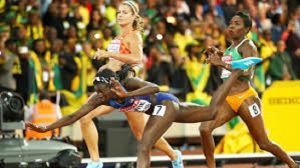Meet The World’s Fastest Woman Tori Bowie
And yet, as the start neared, Bowie was suddenly looking for an exit strategy. “I was saying, ‘I’m not ready!’ ” she recalls. “I was a nervous wreck.” She called her sister for encouragement and then managed to win that first race in much the same way she now typically wins.
 When she medaled in the 100 and 200 meters and the4 X 100–meter relays at the Rio Olympics, for instance, and when she took gold in the 100 and the 4 X 100 at the World Championships in London last year: with a blistering start, her long legs powering her lean frame strong to the turn, and then, in the stretch, a blur of power that put her so far ahead that it appeared as if she were just warming up.
When she medaled in the 100 and 200 meters and the4 X 100–meter relays at the Rio Olympics, for instance, and when she took gold in the 100 and the 4 X 100 at the World Championships in London last year: with a blistering start, her long legs powering her lean frame strong to the turn, and then, in the stretch, a blur of power that put her so far ahead that it appeared as if she were just warming up.
Such is the fierceness of her drive that you can never count her out: On the rare occasion when people have—in, say, the 2017 World Championships in London, where she seemed about to finish in second place—she has managed an upset. In the kind of herculean burst of übercompetitiveness that proves that she’s not merely jet-fuel fast but also focused, she willed herself to lean forward in just the right way at just the right time to hit the finish-line tape first. “Tori has a second gear that nobody else has,” says her sister Tamarra, who ran track with her in high school. “I have never seen it in anybody—we’d be running against each other, and then all of a sudden she would just go. It’s like a special neutron burner.”
Bowie, who like Tamarra was raised by her grandmother in Sand Hill, Mississippi, in the pine- and oak-covered countryside outside Jackson, learned how to compete early, starting with basketball games against boys who showed no mercy. By the time high school came around, she was a forward on a girls’ team that annually finished second in the Mississippi state tournament—something that was hard on Bowie. “Imagine every year coming out defeated,” she says now, shaking her head. When her basketball coach made the team do double duty as a track team, though, that all changed. “From that very first year, we won three championships in a row,” Bowie says.
Next up, the 100 meters at the USA Track and Field Outdoor Championships at the end of June—the 100 meters, by the way, being her second-favorite race. “The 200 is tragic!” Bowie says. “It’s my favorite race, but it takes so much out of the body—and it’s too much time to think.”
Though running takes up nearly all her time when she has a few seconds off she heads to the beach near her home in Florida and dreams of flying to Mexico for “real tequila and real Mexican food.” She deals with the chaos of training and traveling by maintaining a strict game-day focus on the little things—including her nails, inspiration for which she cites the legendary Florence Griffith Joyner. “Flo-Jo definitely sets the bar high,” says Bowie, who’s learning from the late sprinting legend’s example on the track as well. “She was always relaxed before the race, and even during the race,” Bowie says. “That’s what I’m trying to reach this year—I’m trying to relax and let things go.
Being a runner has brought me a lot of patience, and patience goes a long way in life.”
If it seems counterintuitive to hear someone whose whole life is focused on speed and acceleration talk about patience and relaxation, perhaps you’re just not attuned to the finely calibrated rhythm changes built into Bowie’s life.
Back in Oregon, on that fateful day when she pleaded her way into a race, she did actually manage to relax before getting to the starting blocks. Having achieved that state of mind, though, she was set for action.“Once we got on that line,” she says, “I knew it was time to go to war.” “With patient, anyone can achieve anything you are set to achieve,” she said.





